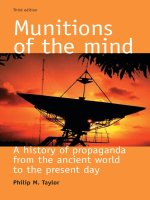manchester university press munitions of the mind a history of propaganda third edition nov 2003
Bạn đang xem bản rút gọn của tài liệu. Xem và tải ngay bản đầy đủ của tài liệu tại đây (2.4 MB, 353 trang )
Munitions
of the mind
Munitions of the mind
A history of propaganda
from the ancient world
to the present day
Philip M. Taylor
Third edition
Third edition
Taylor
‘This scholarly, majestic survey, full of perceptive insights provides
conclusive evidence that propaganda is a process unique to human
communication regardless of time, space and geographic location and
remains an integral part of human discourse. Taylor has done more
than most to enhance our understanding of this complex subject and
Munitions of the mind
forces us to fundamentally rethink how we
popularly regard propaganda … it transcends traditional disciplines
and is in a real sense a multdisciplinary tour de force.’
Professor David Welch, University of Kent (on first edition)
‘A fascinating read and wide-ranging survey which should be essential
reading for anyone interested in the operation and effects of
propaganda.’
Professor Jeffrey Richards, University of Lancaster (on first edition)
A classic work, Munitions of the mind
traces how propaganda has formed
part of the fabric of conflict since the dawn of warfare, and how in its
broadest definition it has also been part of a process of persuasion at the
heart of human communication. Stone monuments, coins, broadsheets,
paintings and pamphlets, posters, radio, film, television, computers and
satellite communications – propaganda has had access to ever more
complex and versatile media.
This third edition has been revised and expanded to include a new preface,
new chapters on the Gulf War, information age conflict in the post-Cold
War era, and the world after the terrorist attacks of September 11. It also
offers a new epilogue and comprehensive bibliographical essay.
The extraordinary range of this book, as well as the original and cohesive
analysis it offers, makes it an ideal text for all international courses
covering media and communications studies, cultural history, military
history and politics. It will prove fascinating and accessible to the general
reader.
Philip M. Taylor is Professor of International Communications at the University of
Leeds. His previous publications include War and the media: Propaganda and
persuasion in the Gulf War.
taylor 5/23/03 11:07 AM Page 1
Munitions of the mind
Munitions_00_Prelims 4/11/03, 10:381
For Professor Nicholas Pronay
Munitions_00_Prelims 4/11/03, 10:382
Munitions
of the Mind
Chapter 9
Manchester University Press
Manchester and New York
distributed exclusively in the USA by Palgrave
A history of propaganda
from the ancient world
to the present era
Third Edition
Philip M. Taylor
Munitions_00_Prelims 4/11/03, 10:383
Copyright © Philip M. Taylor 1990, 1995, 2003
The right of Philip M. Taylor to be identified as the author of this work has been
asserted by him in accordance with the Copyright, Designs and Patents Act 1988.
First edition published 1990 by P. Stephens
Second edition published 1995 by Manchester University Press, reprinted 1998
and 2002
This edition published 2003 by
Manchester University Press
Oxford Road, Manchester
M13 9NR, UK
and Room 400, 175 Fifth Avenue, New York,
NY 1000, USA
www.manchesteruniversitypress.co.uk
Distributed exclusively in the USA by
Palgrave, 175 Fifth Avenue, New York,
NY 10010, USA
Distributed exclusively in Canada by
UBC Press, University of British Columbia, 2029 West Mall,
Vancouver, BC, Canada
V6T 1Z2
British Library Cataloguing-in-Publication Data
A catalogue record for this book is available from the British Library
Library of Congress Cataloging-in-Publication Data applied for
Cu
ISBN 0 7190 6767 7 paperback
This edition first published 2003
11 10 09 08 07 06 05 04 03 10 9 8 7 6 5 4 3 2 1
Typeset in Sabon
by Koinonia, Manchester
Printed in Great Britain
by Bell & Bain Ltd, Glasgow
Munitions_00_Prelims 4/11/03, 10:384
1
Contents
Acknowledgements page vii
Preface to the New Edition viii
Introduction Looking Through a Glass Onion: Propaganda,
Psychological Warfare and Persuasion 1
Part One Propaganda in the Ancient World
1 In the Beginning … 19
2 Ancient Greece 25
3 The Glory that was Rome 35
Part Two Propaganda in the Middle Ages
4 The ‘Dark Ages’ to 1066 51
5 The Norman Conquest 62
6 The Chivalric Code 67
7 The Crusades 73
8 The Hundred Years War 81
Part Three Propaganda in the Age of Gunpowder and Printing
9 The Gutenberg Galaxy 87
10 Renaissance Warfare 89
11 The Reformation and the War of Religious Ideas 97
12 Tudor Propaganda 102
13 The Thirty Years War (1618-48) 109
14 The English Civil War (1642-6) 117
15 Louis XIV (1661-1715) 121
Munitions_00_Prelims 4/11/03, 10:385
Part Four Propaganda in the Age of Revolutionary Warfare
16 The Press as an Agent of Liberty 129
17 The American Revolution 133
18 The French Revolution and the Napoleonic Wars 145
19 War and Public Opinion in the Nineteenth Century 158
Part Five Propaganda in the Age of Total War and Cold War
20 War and the Communications Revolution 173
21 The First World War 176
22 The Bolshevik Revolution and the War of Ideologies
(1917-39) 198
23 The Second World War 208
24 Propaganda, Cold War and the Advent of the
Television Age 249
Part Six The New World Information Disorder
25 The Gulf War of 1991 285
26 Information-Age Conflict in the Post-Cold War Era 298
27 The World after 11 September 2001 315
28 Epilogue 320
Bibliographical Essay 325
Index 332
Contents
vi
Munitions_00_Prelims 4/11/03, 10:386
1
Acknowledgements
I am indebted to the British Academy for financial support aiding the
research for the original edition of this book, and to the following
colleagues for comments and suggestions: Dr Tracy Rihill for her
observations on the ancient sections; Dr Graham Loud for his views on
the medieval period; Professor F. R. Bridge for his comments on the early
modern period. My research students over the years have extended my
knowledge still further: Ilse Howling, Fiona Assersohn, Damien Stafford,
Kate Morris, Dr Nick Cull, Dr Sue Carruthers, Dr Gary Rawnsley, Paul
Rixon, Hossein Afkhami, Steve Bell, and Graham Cook.
A book like this takes many years of gestation and I am delighted
therefore to acknowledge the assistance of many supportive professional
colleagues and friends, especially Dr Tony Aldgate, Dr Steven Badsey,
Philip Bell, Professor Robert Cole, Professor David Culbert, Professor David
Ellwood, Professor Ian Jarvie, Professor John Grenville, Dr Frank
MacGee, David Murdoch, Dr John Ramsden, Professor Jeffrey Richards,
Peter Stead, Dr Richard Taylor, Dr Geoff Waddington, Professor Donald
Cameron Watt, Professor David Welch, Dr Ralph White, Professor John
Young.
My colleagues at the ICS in Leeds also deserve mention for bringing
different disciplinary perspectives to my thinking: Dr David Morrison,
Howard Smith, Dr Brent MacGregor, Dr Simeon Yates, Dr Richard
Howells, Dr Steven Lax, Judith Stamper, Dr Robin Brown. Former
students offered considerable help in various aspects of the research,
especially Debbie Whittaker, Cheryl Johnson and Ian Bremner. But as a
whole, my history students from 1978-90, and my communications studies
students since 1990 will probably never appreciate how significant they
have been in helping to shape my thoughts on this topic. At least my wife,
Sue, knows of her contribution.
Munitions_00_Prelims 4/11/03, 10:387
This book first appeared in 1990, with a second edition in 1995. It was,
until recently, the only single volume history of propaganda from the
ancient world to the present day. No such volume can purport to be
comprehensive, but it has proved necessary to update the final chapters
and to add new ones that embrace the Balkan wars (including the 1999)
Kosovo campaign and, of course, the so-called ‘war’ against international
terrorism. As I write this new preface, the world is gearing up for another
possible war against Saddam Hussein in Iraq. Leaflets have already been
dropped there. This book attempts to place the conduct of propaganda
during these events within a wider historical context. It retains its main
thesis that propaganda is a much misunderstood word, that it is not
necessarily the ‘bad thing’ that most people think it is. As a process of
persuasion, it is value neutral. Rather, it is the intention behind the
propaganda which demands scrutiny and it is that intention which begs
value judgements not the propaganda itself.
Much has happened since 1995, not least the terrorist attacks on New
York and Washington on 11
September 2001, or ‘9/11’ as it is now
currently being described in shorthand. We are in the middle of another
major propaganda campaign, although it is often difficult for us to identify
it for what it is because we are living through it. News and views are all
around us, speculation is rife, sides are being polarized. Indeed, the issue of
Iraq notwithstanding, we may be on the verge of the greatest propaganda
campaign ever seen as the West struggles to convince the Muslim world
that this is not a war against Islam when many in the Islamic world
genuinely believe that it is. President George W. Bush warns that the
United States is in it ‘for the long haul’. If so, then we will see a new global
struggle for hearts and minds that may be on a par with the Cold War.
This book should, until its next edition, provide some clues as to how to
identify propaganda for what it is, how it has evolved and – most impor-
tantly – to judge for oneself the intentions behind those undertaking it.
Crag Bottom Farm, Two Laws
31 December 2002
Preface to the New Edition
Munitions_00_Prelims 4/11/03, 10:388
From the perspective of our modern information and communica-
tions age, the word ‘propaganda’ continues to imply something
evil. For some it is a cause of wars; for others, it is an even greater
evil than war. Writing in 1926, Lord Ponsonby echoed the senti-
ments of many when he wrote that propaganda involved ‘the
defilement of the human soul [which] is worse than the destruction
of the human body’. For the liberal-minded, its continued
existence remains a cancer threatening to eat away at the body
politic of our increasingly free and globalized society; a disease
which somehow afflicts our individual and collective capacity to
make up our own minds about what is happening in the world
around us. Propaganda, it is felt, forces us to think and do things
in ways we might not otherwise have done had we been left to our
own devices. It obscures our windows on the world by providing
layers of distorting condensation. When nations fight, it thickens
the fog of war. Propaganda thus becomes the enemy of independent
thought and an intrusive and unwanted manipulator of the free
flow of information and ideas in humanity’s quest for ‘peace and
truth’. It is therefore something which democracies, at least, ought
not to do. It suggests the triumph of emotion over reason in a
bureaucratic struggle by the machinery of power for control over
the individual. It is a ‘dirty trick’ utilized by ‘hidden persuaders’,
‘mind manipulators’ and ‘brainwashers’ – Orwellian ‘Big Brothers’
who somehow subliminally control our thoughts in order to con-
trol our behaviour to serve their interests rather than our own.
But who are these propagandists? We all know about Dr
Goebbels, the ‘Evil Genius’ of Nazi propaganda. But where do his
counterparts lie, because lying is, after all, what they do? Since they
Introduction
Looking Through a Glass Onion:
Propaganda, Psychological Warfare
and Persuasion
Munitions_01_Intro 4/11/03, 8:181
bear false witness, propagandists automatically break the Ninth
Commandment, but to tell the Big Lie, they invariably invoke the
Eleventh: ‘thou shall not get found out’. This predisposition to
remain hidden only makes them even more dangerous. In times of
war, when passions and emotions run high and are thus more
susceptible to manipulation by the conflicting parties, democracies
are reluctantly forced to accept that they might need to fight fire
with fire. Yet even then, propaganda is surely what the ‘enemy’
says and does because whereas ‘they’ tell lies, ‘we’ engage in the
truth. Propaganda is thus something done by other, less scrupulous
people; it is an enemy conducted by an enemy.
This book will challenge these various assumptions. Propaganda,
as one British Foreign Office official put it in the late 1920s, is a
‘good word gone wrong’. We are all in fact propagandists to vary-
ing degrees, just as we are all victims of propaganda. That state-
ment will perhaps shock people who misunderstand the real nature
of propaganda. The word carries so many negative connotations
that this would be an entirely understandable reaction. But we need
first to get rid of such baggage and start thinking in more objective
terms. The questions that need to be asked are in a sense more
revealing than any answers that may emerge. We will need to draw
from several disciplinary approaches, transcending traditional arts-
science divisions. Scientists, for example, use the word propagation
in quite different ways. Botanists use it with reference to plants.
Biologists talk of propagating germs and germ cultures. Social
scientists, however, have tended to regard propaganda as being
related more to biology than to botany, perhaps forgetting about
how penicillin was discovered. Hence in political and sociological
analyses of this subject, it tends to resemble a form of germ warfare
on the mind rather than being about the cultivation of ideas. But if
we begin by taking a leaf from the botanists, a new perspective on
the subject becomes possible. Propaganda thus becomes a process
for the sowing, germination and cultivation of ideas and, as such,
is – or at least should be – neutral as a concept. The problem is that
human beings frequently inject morality into processes. Yet before
we can peel away the multifaceted layers of this glass onion, we
first need to understand how it historically acquired a pungency it
does not inherently possess.
When the Vatican gave us the word ‘propaganda’ in the seven-
teenth century to describe its organization to defend ‘the true faith’
Introduction2
Munitions_01_Intro 4/11/03, 8:182
against the challenge of the Protestant Reformation, the heretics
shouted foul at such outside interference in the development of
their ‘natural’ religious thought processes. The legacy of distrust
against the word in Protestant societies remains to this day. But its
recent pejorative connotations date mainly from the excesses of
atrocity propaganda during the Great War of 1914-18 when the
modern ‘scientific’ use of propaganda came of age. It was that
development – and particularly its association with falsehood –
which Lord Ponsonby denounced so vehemently. The odour got
worse when it was employed by the Nazis, the Soviets and other
thoroughly nasty regimes ever since. However, it is all too easily
forgotten that it was the British who, during the First World War,
set the standard in modern propaganda for others to follow.
As we shall see, falsehood was not a watchword of that experi-
ment, the first to attract considerable scholarly attention. It was no
more the policy of the official British wartime propaganda machin-
ery to lie deliberately than it was to tell the whole truth. Facts were
deployed selectively yet rationally, while falsehoods were eschewed
in the belief that they would ultimately be exposed and thereby
jeopardize the credibility of those facts that had been released. The
government preferred to lie by omission, not by commission. The
majority of wartime falsehoods – and there were many – were in
fact circulated by a free and highly jingoistic press, not by the
official propagandists, but the damage had been done. Nor were
matters helped by the great praise subsequently heaped on the
British use of propaganda by the likes of Adolf Hitler in Mein
Kampf who went on to adapt the lessons of the British experience
for his own, quite different, purposes. Moreover, in the United
States, isolationist elements were quick to seize upon post-First
World War revelations about the extent of British propaganda
directed against neutral Americans between 1914 and 1917.
Washington, they argued, had been ‘duped’ into joining the allied
side and this, in turn, was used to reinforce their own arguments
about the need to avoid future foreign entanglements. Propaganda
thus bred propaganda. It might seem ironic, therefore, that it is the
Americans who today stand as the masters of its art, science and
craft. But even though both Britain and the United States, as
pluralistic democracies, normally fight shy of the word, that does
not mean that they do not engage in it. Nor does it automatically
mean that they are wrong to do so.
Introduction 3
Munitions_01_Intro 4/11/03, 8:183
The reason for this is that, before 1914, propaganda simply
meant the means by which the converted attempted to persuade the
unconverted. The converted were, and are, not necessarily nasty
people with nasty ideas; nor were, or are, the unconverted particu-
larly unreceptive or resistant to what they are told. After all, it takes
two sides to form allegiances. Much propaganda in fact also takes
place between the converted and the already converted. This is why
the Bolsheviks preferred the word ‘agitation’ to describe the discourse
between party and people, between source and target; ‘propaganda’
was used to describe the indoctrination of its party members, the
already converted, before they went out to agitate amongst the
people. But before we return to this, we need to consider some
further aspects of propaganda’s tarnished image. It is frequently
charged with guilt by association with two time-honoured human
activities: power and war. With the former, propaganda has always
been an additional instrument in the arsenal of power, a psycho-
logical instrument, and it is its relationship to power which has
attracted suspicion – mainly from the powerless or those resentful
of power. Much propaganda in fact emanates from power rather
like spontaneous combustion, as the British who started the century
as the world’s greatest power and the Americans who ended it
having inherited that mantle know only too well. ‘Power speaks for
itself.’ But in both countries it was equally recognized that propa-
ganda by itself cannot win any struggle for allegiances – hence the
need in many instances to back it up with force or coercion, which
can range from the passing of mild punitive legislation to the
imprisonment or extermination of opponents. The more extreme
measures are especially characteristic of authorities – authoritarians –
which are insecure about whether their messages will command, at
best, general approval or, at least, popular acquiescence.
To be completely convincing, however, shadow does require some
substance and myth needs to be rooted in some reality if propa-
ganda is to succeed. Those realities can, of course, change and
propaganda needs to adapt accordingly. In pluralistic democracies
which purport to exist on the basis of consensus rather than
coercion, persuasion thus becomes an integral part of the political
process. And once we start talking about persuasion, we enter the
psychological dimension of interpersonal, not to mention national
or international, relations which has always been a significant
element in the political, military, social or economic instruments of
Introduction4
Munitions_01_Intro 4/11/03, 8:184
power. In the struggle for power, propaganda is an instrument to
be used by those who want to secure or retain power just as much
as it is by those wanting to displace them. For the smoke to rise,
there must first be a spark which lights the flame. Propaganda is
that spark.
This perhaps explains why propaganda and war have always
been inextricably connected. Once war has broken out, propaganda
has proved to be a weapon of no less significance than swords or
guns or bombs. But it cannot normally be divorced from military
realities. ‘Victory generates its own support.’ But propaganda does
not itself kill people. Indeed, it can be an alternative to killing, the
triumph of communication over violence. It can, however, create
myths – not just about why wars begin, are won or are lost, but
even on rare occasions transform defeats into victories (Dunkirk,
1940, immediately springs to mind). But words alone rarely win
wars. The munitions of the mind, like other conventional weapons,
have admittedly become more sophisticated with advances in
technology, but yesterday’s epic poem or painting is really no more
than the equivalent of today’s propaganda film or television
broadcast. It is when propaganda is employed in the service of
violence, however, that we begin to mistrust it, because it encour-
ages people to kill people, or to acquiesce in that slaughter. Today
it assumes the appearance of a devious weapon that once seduced
the souls and the minds of men, exploiting their natural aggression
to drive them periodically on to the battlefield.
To understand what drives people to violence would require at
least another book. Here we can only begin to tackle the methods
of persuasion which have been used throughout history to persuade
people that violence is an acceptable course for them to pursue. We
must thus beware the dangers of extrapolating twentieth-century
perceptions on to our understanding of earlier periods. The same
might equally be said for the notion of propaganda as we currently
(mis)understand it – but only if we fail to regard it as a neutral pro-
cess of persuasion. If we do this, we fall into the trap of labelling
something ‘good propaganda’ or ‘bad propaganda’, as a persuasive
process which we judge from the standpoint of our own core
values. Thus the process earns approval because we agree with it,
and disapproval because we disagree with it. Propaganda becomes
something which is done by others we differ from who are selling a
cause which we repudiate; hence they are telling lies or, at best, not
Introduction 5
Munitions_01_Intro 4/11/03, 8:185
telling us ‘the truth’ – and we are back to where we started from.
When one person’s beliefs become another’s propaganda, we have
already begun to take sides in a subjective manner. Propaganda
analysis demands objectivity if it is to be undertaken effectively.
Although the scale on which propaganda has been practised has
increased out of all recognition in the twentieth century, it is in fact
an activity that does date back to the time when human beings first
began to communicate with one another. Essentially, propaganda
is really no more than the communication of ideas designed to
persuade people to think and behave in a desired way. It differs – or
should do – from education in that the imparting of information
and ideas for educational purposes is to enable the recipient to
make up his or her own mind on any given issue. Propaganda is
about persuading people to do things which benefit those doing the
persuading, either directly or indirectly. In wartime that usually
means getting them to fight or to support the fight. I do not mean
to imply by this that getting people to fight wars is right, merely
that propaganda serves an essential role in persuading people to
risk their lives for whatever the reasons or the cause. It is those
reasons and causes which should be the legitimate objects of moral
and critical analysis and judgement, not the propaganda itself. As
such, propaganda can be used for ‘good purposes’, just as it can be
abused. If the history of propaganda in the twentieth century
appears to be largely a history of abuse, it does not follow that this
has always been, and always will be, the case.
By propaganda, then, I mean the deliberate attempt to persuade
people to think and behave in a desired way. Although I recognize
that much propaganda is accidental or unconscious, here I am
discussing the conscious, methodical and planned decisions to
employ techniques of persuasion designed to achieve specific goals
that are intended to benefit those organizing the process. In this
definition, advertising thus becomes economic propaganda since
the marketing of a product is designed to advance the manu-
facturer’s profits. It may well be that those at the receiving end of
the process also benefit, but in that case the word ‘publicity’ would
be a more appropriate label. Public relations is a related com-
municative process designed to enhance the relationship between
an organization and the public and, as such, is a branch of
propaganda, albeit a nicer way of labelling it.
Similar euphemisms abound: ‘public information policy’, ‘press/
Introduction6
Munitions_01_Intro 4/11/03, 8:186
media relations’ or, more recently, ‘spin doctoring’. The euphemism
business is, of course, a response to the bad smell but merely serves
to add more layers obscuring the reality. Because propaganda is
here defined as a deliberate attempt to persuade people, by any
available media, to think and then behave in a manner desired by
the source, it is really a means to an end. The methods employed
vary according to the communications media available. Communi-
cation with a view to persuasion is an inherent human quality. It
can take place in a private conversation or a mass rally, in a church
or cinema, as well as on a battlefield. It can manifest itself in the
form of a statue or a building, a coin or painting, a flag or a postage
stamp. Propaganda is simply a process by which an idea or an
opinion is communicated to someone else for a specific persuasive
purpose. Speech, sermons, songs, art, radio waves, television pictures,
one person or millions of people – again, none of these matter here
for purposes of definition. Communication, though essential to the
process, does not by itself provide us with an adequate conceptual
starting point. Communication, after all, is just as important for
education or advertising. No, what distinguishes propaganda from
all other processes of persuasion is the question of intent. Propa-
ganda uses communication to convey a message, an idea, or an
ideology that is designed primarily to serve the self-interests of the
person or people doing the communicating. It may well be that the
audience does not want to hear the message; but equally it may
well be that it does. Unwanted propaganda, however, does need to
be detected in the first place before it can be evaluated. For
purposes of definition, it matters not whether the desired behaviour
results from the effort; that is the difference between successful and
unsuccessful propaganda. Success, however, also needs to be
measured against the intention behind the process. But we cannot
here involve ourselves in debates about whether the end justifies
the means. When, for example, we talk of a ‘Just War’, then surely
the propaganda designed to support it is justified? And if a war is
‘necessary’ then surely so also is the propaganda it engenders? The
problem, when all else is said and done about any issue which
arouses human judgements – whether they be historical, economic
or moral – is that people seize upon answers that really depend on
which side they were on in the first place. The Vatican was in a
sense right to call its organization the Congregatio de Propaganda
Fide, the Congregation for the Propagation of the Faith, because
Introduction 7
Munitions_01_Intro 4/11/03, 8:187
when all these issues are stripped of their theoretical flesh, perhaps
human beliefs are really a matter of faith. Hence propaganda
appears most effective when it preaches to the already converted.
This book is therefore concerned simply with means – with
persuasive methods – not with ends. It does not address whether a
product (such as a war or a religion) is itself needed or unwanted,
or whether it is right or wrong, just or unjust. It simply examines
the means by which those products were marketed, successfully or
otherwise. There is no real point, in other words, in making moral
judgements concerning whether propaganda is a ‘good’ or a ‘bad’
thing; it merely is. Rather, one needs to redirect any moral
judgement away from the propaganda process itself and more to
the intentions and goals of those employing propaganda to secure
those intentions and goals.
Similarly, with psychological warfare – propaganda directed
usually against an enemy – the same sort of pejorative connotations
need to be peeled away before we can begin to understand the
process fully. After all, why should there be such a stigma surround-
ing a process of persuasion designed to get people to stop fighting,
and thus preserve their lives, rather than having their heads blown
off? Today, as we learn more and more about the workings of the
human mind in an era where nuclear weapons could readily destroy
all human life on the planet, propaganda and psychological opera-
tions (as they are now called) have become genuine alternatives to
war. As this book will argue, that is what the Cold War was really
all about, as are indeed many of the contemporary ‘information
wars’ which now accompany international crises. Propaganda is
part of the struggle for perceptions in which words attempt to
speak as loud as actions, and sometimes even to replace the need
for action. It works most effectively when words and deeds (the
propaganda and the policy) are synchronous, but the ‘propaganda
of the deed’ is in itself a powerful persuader. When Rome destroyed
Carthage, for example, or when the Americans dropped atomic
bombs on Hiroshima and Nagasaki or when battleships are despatched
to the coastline of a weaker adversary, such actions send powerful
messages that form part of the persuasive process that operates in
the psychological dimension of human communication.
But we do need constantly to bear in mind why we as indivi-
duals believe what we do. A great deal of theory works on the
assumption that information is power, and whoever controls the
Introduction8
Munitions_01_Intro 4/11/03, 8:188
flow of information therefore wields power over the recipient.
Propaganda is thus a powerful tool for perpetuating power relation-
ships. The problem in much propaganda theory is that the
recipient is also felt to be empowered as well, in other words, he or
she can reject the messages – provided they can be detected. This
book might almost be regarded as a handbook to aid that detec-
tion. Although much modern propaganda appeals to reason, it is
more usually felt to play on emotion, with the young being
particularly vulnerable to such emotional manipulation. But are
adults so immune? Scholars from a variety of disciplines have long
pondered this question. Yet, regardless of whether the prevailing
theory of the time was that we behaved the way we did because of
‘God’s will’ or because we were ‘possessed by spirits’ or even
because we have evolved into masters of our own destiny through
a contest of the ‘survival of the fittest’, it has only been in the past
hundred years or so, with the rise especially of psychology, that the
focus of attention has been on the workings of the human brain
rather than on the mysteries of the human ‘soul’.
If war is essentially an organized communication of violence,
propaganda and psychological warfare are essentially organized
processes of persuasion. In wartime they attack a part of the body
that other weapons cannot reach in an attempt to affect the way in
which participants perform on the field of battle. However, in the
centuries before nuclear technology and psychology, before the
likes of Einstein and Oppenheimer, of Freud and Jung, neither
propaganda nor warfare had been demystified or discredited. The
battlefield was where individuals and States earned their place in
history. It is important, in other words, to remember that because
the cult of war is much older than the cult of peace, propaganda
designed to get people to fight is a much older process than the
relatively underdeveloped form of propaganda designed to get
people to fight for peace.
Perhaps, in this current century, this century of the mass media
as well as of Total Warfare, Cold Warfare and Nuclear Weapons,
we have seen more of the horrors of war than any of our predeces-
sors and we are therefore more aware of its consequences, with the
result that we tend to place more emphasis on the merits of peace.
Yet prior to this age, war was regarded as a normal, even accept-
able and indeed glorious, method of resolving disputes, an extension
of politics and diplomacy by other means. But did people then see
Introduction 9
Munitions_01_Intro 4/11/03, 8:189
warfare through the rose-tinted spectacles provided by propagan-
dist opticians who wanted to masquerade its brutal realities? As
consumers of the mass media, is it any different for us today? Just
how realistic or authentic is the view of war held by non-
combatants? Or are we just as blinkered as our predecessors were?
An essential characteristic of propaganda is that it rarely tells
the whole truth. We do not need here to get into post-modernist
theories about concepts of ‘truth’ or ‘reality’ to realize from this that
censorship is the essential counterpart to propaganda. They are
different sides of the same coin: the manipulation of opinion. The
selective processes by which some information is disseminated and
some held back is a problem facing all communicators, but where
censorship operates – whether it be institutionalized or self-
censorship – one needs to recognize how close one is sailing into the
wind of propaganda. This is particularly true if the deliberate with-
holding of certain information is designed to benefit those who
control the flow of information in the first place. However, censors
of all persuasions take refuge in the notion that they are somehow
protecting someone else from something that may do them
damage. But invariably they are protecting their own interests for
fear that information may indeed empower people to think and do
things that might not serve or benefit those interests. This was why
Hitler felt that it was pointless to attempt propaganda against
intellectuals; they would always be able to identify propaganda
when confronted with it. Hence the need for us to be clear on the
difference between propaganda and education, although again the
British experiment in the First World War, when foreign opinion-
formers were the principal targets of propaganda emanating from
Wellington House rather than public opinion itself, provides a
salutary reminder of the susceptibility of even the most educated.
In wartime, censorship is today imposed with the justification
that certain information which might serve the interests of the
enemy, and thus jeopardize the lives of those doing the fighting on
‘our’ behalf, must be withheld on the grounds of ‘operational
security’. But it is no coincidence that modern military censorship
coincides with the arrival of the profession of the war correspon-
dent. Nor is it a coincidence that the advent of mass communica-
tions in the mid nineteenth century and the extension of political
and military activity to a much broader population base have
sparked off an explosion in the use of propaganda world-wide.
Introduction10
Munitions_01_Intro 4/11/03, 8:1810
Ever since William Howard Russell’s despatches for The Times
during the Crimean War, the needs of military secrecy have clashed
with the demands of media publicity and, with it, the battle to
control the flow of information which might have an adverse effect
on military and civilian morale. Modern censorship and propa-
ganda are thus institutional responses to the ‘communications
revolution’ which we are still undergoing today.
What that much used phrase actually means is essentially a shift
from face-to-face communication towards mediated forms of com-
munication in which a third party intervenes in the communication
process between sender and recipient. Usually that third party is a
medium such as a newspaper or television. If the consequence of
this is that previous problems of distance and time between sender
and recipient have been narrowed by the existence of the media,
fourth parties such as propagandists and censors (and advertisers and
other persuaders) also try to infiltrate the remaining space between
them. With the arrival of instantaneous communication between
sender and recipient – live television news reports, computer-
mediated communications – there is no such space remaining. The
challenge for today’s propagandist/censor, therefore, is to gain control
of information at source. If that does not work or is not possible,
there is either a need to control the ‘spin’ on the information flowing
out – crisis management – or to ensure that the information being
received is done so by people who have already been sufficiently
infused with propaganda over a long period of time so that they
perceive it in accordance with a predetermined world-view. Hence
unpalatable information falls on barren ground because people
cannot see where it fits into their way of seeing and believing.
Psychologists call this cognitive dissonance. French sociologist
Jacques Ellul, who has produced one of the most stimulating con-
ceptual examinations of propaganda, argued that the advent of the
technological society was a major factor in the emergence of
modern propaganda because that type of society conditioned
people to a ‘need for propaganda’. In his view, propaganda is most
effective when it conforms to needs that already exist, but these are
in fact ‘pseudo-needs’ created from childhood to cater for ‘pseudo-
satisfactions’ created by an all-embracing propaganda society.
Previously, especially if wars were fought ‘somewhere else’, this
required the creation of a perception gap between the image of
warfare projected towards civilian audiences and its brutal realities
Introduction 11
Munitions_01_Intro 4/11/03, 8:1811
as experienced by the soldiers. Today, that gap appears to have been
substantially narrowed by the presence of the mass media, and
especially television. But is this in fact the case? Or does it merely
raise new problems for the projection and presentation of warfare?
The Roman writer Livy wrote that ‘nowhere do events corres-
pond more to men’s expectations than in war’. Yet even volunteer,
professional troops suffer from low morale and even panic if there
is too wide a gap between the expectations of what war will be like
and its realities on the battlefield. Factors such as bad weather,
poor food and low pay can sap the morale of even the best-trained
armies. Discipline and training designed to foster mutual reliance
are essential factors in maintaining good fighting spirit, but this is
difficult with conscripted troops reluctant to fight or fearful of
their fate. Hence the use of incentives such as money, social status,
personal or family or national glory, and even religious promises of
everlasting life. A brave soldier who becomes a war hero might have
all of these things; a coward would be denied them. Hence propa-
gandists exploit both positive and negative incentives in order to
persuade men to overcome their fear and risk their lives in the most
brutal and terrifying of circumstances.
But what about the reasons for the soldier being there in the first
place? Throughout history, great emphasis has been placed upon
the justness of the cause for which men must go to war. Yet, as Lord
Wavell wrote in 1939, ‘a man does not flee because he is fighting in
an unrighteous cause; he does not attack because his cause is just’.
Wavell’s view was that good morale was determined by the degree
to which a soldier felt part of a cohesive unit, a small core of
mutually reliant individuals, and the degree to which that unit
identified with the society on whose behalf it was fighting.
Propaganda for and about war, therefore, cannot be studied
merely by confining its analysis to the battlefield. It requires a much
wider context extending into every aspect of society. At the end of
the eighteenth century, Thomas Malthus wrote that ‘a recruiting
serjeant always prays for a bad harvest, and a want or unemploy-
ment, or, in other words a redundant population’. Motivating men
to fight – for the history of warfare is largely the history of male
aggression – has always been a major problem for history’s recruit-
ing serjeants. Hence the need to glorify and publicize military
achievements to a wider public in order to increase the sense of
mutual identification. Soldiers fight better if they know that their
Introduction12
Munitions_01_Intro 4/11/03, 8:1812
families, friends and the civilians who are waiting for news of their
deeds from afar support their actions. With volunteers, there may
appear to be little need for propaganda, although the pressures of
society at war often make it easier to join up than it is to stay at
home. (Hence the First World War campaign poster of ‘What did
you do in the Great War, daddy?’.) But there have always been men
who enlist voluntarily for a variety of personal reasons that require
little propagandist attention: the life-style, the physical training,
travel, adventure, uniforms, money, family tradition, patriotism. In
militaristic societies, such as ancient Sparta or eighteenth-century
Prussia or in their twentieth-century counterparts, the central role
of the army in society provided opportunities of wealth and status
that attracted the ambitious. We cannot therefore discount the
militaristic propaganda that permeated all aspects of life in such
societies as a motivating force in recruitment. But nor, in other
types of societies, can we discount propaganda surrounding ‘the
just war’ or other justificatory themes. Soldiers may not attack
because they believe their cause is just – although it must surely
help. They attack because they are trained and disciplined to obey
orders on command. But a just cause none the less has to be
marketed to a wider audience in order to justify not so much ‘why
they fight’ but rather ‘why we must support them’.
We will never know for certain whether any given war might
have had a different outcome if more or less propaganda had been
conducted effectively by either side. We do know, however, that
history tends to be written mainly by the victors, and to the victors
go the spoils of historical judgement. Does this mean, therefore,
that history is propaganda? Indeed to what extent are the educa-
tional systems of societies serving propagandist needs? Studies of
school textbooks in Nazi Germany and Imperial Japan have
demonstrated that history books in those countries said more
about the time in which they were written than about the past. No
one would doubt this any more in so far as the old Soviet Union
was concerned now that archives are being opened to reveal the
extent to which education was used as a form of social and
political engineering. Democratic regimes, however, cherish the
illusion that their history books do not overtly manipulate
historical facts – even though a glance at American history books
of the early 1950s or books written in Britain at the height of the
Empire would indeed confirm this to be an illusion.
Introduction 13
Munitions_01_Intro 4/11/03, 8:1813
The difference, of course, is that no official propagandist body
decreed that Anglo-American history or other books should be
written to project a predetermined view of the past to conform
with the political needs of the present. Even so, the scholars who
wrote them were products of the times in which they lived and
worked. And rarely has there been a time in history when the
governors have not attempted to influence the way in which the
governed viewed the world, including that of their own past.
Information, whether current or redundant, retains its capacity to
shape perception. For this reason, history has indeed proved to be
an invaluable source of propaganda, and not just in dictatorships
or authoritarian regimes. In societies which purport to cherish
such notions as freedom of information, freedom of thought, word
and deed, what then is the difference between propaganda and
education? Perhaps the answer lies in the idea that propaganda
tells people what to think whereas education teaches people how
to think. The line is, however, much thinner in practice than in
theory. Interestingly, modern dictatorships have never fought shy
of the word ‘propaganda’ in quite the same way as democracies do.
The Nazis had their Ministry of Popular Enlightenment and
Propaganda and the Soviets their Propaganda Committee of the
Communist Party, but the British had a Ministry of Information
and the Americans an Office of War Information. We must not
forget that all, however, practised censorship.
Historically, modern propaganda can be seen as a product of
post-industrialization where people become consumers. But people
do not like to think they would pay for propaganda, so propaganda
has to be paid for by others – the State, say, or even the church –
who spend money on this activity to suit their own needs, rather
than the people’s. The package is of course marketed in such a way
that it is the consumers who believe they are the beneficiaries. Since
the Enlightenment, consumers of ideas likewise prefer to believe
that they can access information freely as and when they need it
with minimum outside interference. In this way can propaganda be
identified and then rejected. But is this notion also an illusion?
Now, in an age that is witnessing a massive explosion of inform-
ation – with its talk of ‘information superhighways’, digital data
networks and global satellite television services – this issue remains
one of the most central concerns of our time. How freely does that
information flow? Is anyone controlling it in any way? If so, why?
Introduction14
Munitions_01_Intro 4/11/03, 8:1814
Are we being told everything? Is what we see, hear and read an
unfettered representation of what is really happening? What are
we not being told, and why? Is the information on which we base
our opinions and perceptions of the world around us free from the
influence of propaganda? If not, is that to our benefit or advantage?
Answers to such questions can emerge only slowly, whereas the
technology is now moving so quickly that scholars who begin to
tackle them barely have time to catch their breath before another
new technological breakthrough commands their attention.
Yet such questions can only begin to be answered by a careful
study of the way in which our information age functions and the
ways it is developing. It is a study that needs to transcend tradi-
tional academic disciplines but one which none the less requires an
historical framework. However, to reiterate, it must be borne in
mind that the study of propaganda itself is not necessarily the
study of something evil. The Ancient Greeks, after all, regarded
persuasion as a form of ‘rhetoric’ and it was Aristotle who believed
that the purpose of persuasion was to communicate a point of view
and that knowledge and wisdom could only be secured through
logic and reason. As we shall see, the most effective propaganda as
it has evolved through the ages now bases itself upon ‘facts’ and
credible arguments, upon as near (not as far) as possible ‘the whole
truth’, upon reason rather than emotion. But whatever ‘the whole
truth’ is or wherever it resides, the study of propaganda requires us
first to look at ourselves: what we think, why we think it, whether
we choose to think something because of some facet of our
upbringing, our environment, our education or our individual
experience or because someone else has suggested that that is the
way to think for their benefit rather our own. Only then can we
begin to understand whether our windows are in fact mirrors, or
indeed whether the mirrors are prisms.
In so far as war is concerned, only the most optimistic of people
can believe that it will ever be permanently eradicated from human
behaviour. The continuing threat of nuclear weapons to human
survival remains, however, a sobering reminder of the need to con-
tinue the effort. Rethinking the possible applications for propa-
ganda is therefore an important element of meeting the challenge
laid down by history to our contemporary age. As Albert Camus
wrote earlier this century:
Introduction 15
Munitions_01_Intro 4/11/03, 8:1815
Over the expanse of five continents throughout the coming years an
endless struggle is going to be pursued between violence and friendly
persuasion … Henceforth the only honourable course will be to stake
everything on a formidable gamble – that words are more powerful
than munitions.
Introduction16
Munitions_01_Intro 4/11/03, 8:1816









